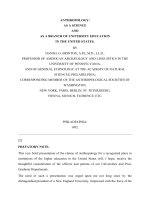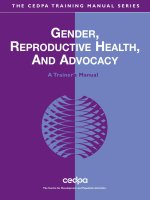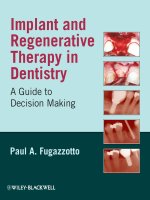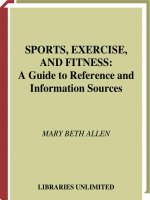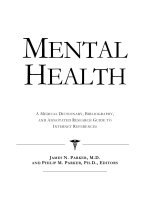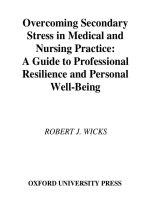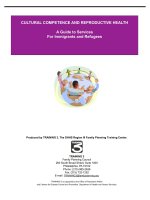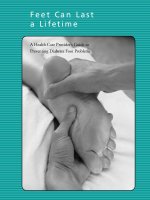Promoting Student Health and Wellbeing: A guide to drug education in schools ppt
Bạn đang xem bản rút gọn của tài liệu. Xem và tải ngay bản đầy đủ của tài liệu tại đây (376.46 KB, 45 trang )
Promoting Student Health and Wellbeing
A guide to drug education in schools
1
Table of contents
Introduction 3
Section 1 4
Promoting healthy, confident young people 4
Schools can make a difference 8
Alignment with the national curriculum 11
The vision 11
The principles 12
The values 13
Key competencies and graduate profiles 13
Developing and sustaining a school culture of health and wellbeing 16
Polic
ies and procedures 18
Involving the community 19
Meeting legal requirements 19
Learning opportunities across the school curriculum 21
Managing drug-related incidents 22
Managing drug-related incidents chart 23
Section 2 24
Drug education within the national curriculum 24
The learning environment 24
Teachers as facilitators of learning 25
Students as learners 26
Community in partnership 27
Providing effective professional development for teachers 28
Using external providers 29
Guidance for teaching and learning programmes in drug education 31
Drug education matrix of learning outcomes for levels 1–8 within the health and
physical education/hauora areas of the national curriculum 31
The structure of the matrix 35
Where to g
o for further help/information 45
2
Introduction
Promoting Student Health and Wellbeing: A Guide to Drug Education in Schools
is intended for school Boards of Trustees, principals, and teachers of drug
education within the context of the health and physical education curriculum.
The guide provides information and guidance for schools on developing and
implementing drug education programmes. It also outlines how these
programmes are supported by a whole-school approach to promoting health and
wellbeing that links to wider school communities.
While readers are encouraged to become familiar with the full resource, it has
two sections, of which one may be more relevant to a particular audience than
the other.
Section 1, on pages 4-23, is primarily for those concerned with school
governance and strategic planning – that is, Boards of Trustees and principals. It:
• describes the need for drug education and schools’ potential role in
helping to reduce harm from drug use
• outlines how schools can use drug education to achieve the vision and
goals of the national curriculum
• discusses the importance of promoting student health and wellbeing
through a whole-school approach, developed in partnership with the wider
community
• provides an overview of suggested procedures for managing specific drug-
related incidents.
Section 2, on pages 24-44, is primarily for classroom teachers and curriculum
planners. It:
• focuses on the place of drug education within the health and physical
education curriculum
• provides guidance for teaching and learning programmes
• includes the ‘Drug Education Matrix of Learning Outcomes’, which outlines
the knowledge, understanding and skills that students should develop at
Levels 1-8 of the national curriculum.
3
Section 1
Promoting healthy, confident young people
Schools, teachers and the whole school community have a role in providing a
safe and supportive environment for young people – so that they can develop
appropriate attitudes, knowledge, skills and competencies to make positive,
healthy choices about the use of drugs (including alcohol and tobacco).
The behaviour, values and beliefs of parents, families/whānau and other
members of their community have a powerful influence on young people’s
developing attitudes to drugs. Young people are also influenced by the messages
they receive from the media and marketing campaigns. Pop culture, music and
music videos, online media and electronic messaging services, television and
advertisements can all portray powerful, positive, glamorous images of drug use.
Young people are particularly susceptible to these images, and as they grow up
will need to make decisions about drug use away from the help of trusted adults.
Young people need support to be able to make responsible, informed decisions
about drugs for themselves.
Evidence shows that a range of behaviours, including those associated with drug
use, can be positively affected by strengthening families/whānau and
relationships between parents and their children, empowering communities to
identify risk and protective influences, and building individual resiliency
1
.
Reducing harm from drug use is a collective responsibility between young
people, schools, parents, families/whānau and communities. As part of the
communities in which young people grow up, schools contribute through
developing competent and confident young people who are healthy of mind, body
and soul, secure in their identities and sense of belonging.
1
Midford, R. & Munro, G. (eds) (2006). Drug Education in Schools: Searching for the silver bullet.
Melbourne: IP Communications, Chapter 5.
4
Drug use among young people
Drugs use affects all school communities in New Zealand. It is associated with
health risks, including injury, problem behaviours, depression and other risk-
taking activities, and affects students’ welfare and safety, social relationships and
identities, and their ability to learn and achieve their full potential.
Problems arising from drug use among young New Zealanders are primarily
associated with alcohol, tobacco and cannabis. While the use of these
substances is evident in all communities in New Zealand, the extent of youth
drug use is often portrayed in the media in sensational terms, with the potential
for popular myths to develop that may not reflect reality.
Schools need to understand the actual situations and students’ needs in their
communities, and use robust, verifiable evidence to support their decision-
making.
Data on drug use among primary school students is not available owing to ethical
constraints, but data from secondary school students indicates that alcohol and
tobacco use is commonplace and that many young people have been exposed to
cannabis use. Recent results from the Youth07 survey showed that:
- 72% of students had tried alcohol. The majority (61%) currently drank alcohol.
One-third reported that they had engaged in binge drinking (five or more drinks in
four hours) in the previous four weeks. 16% had been told by friends or family
that they needed to cut down their drinking
- almost 8% of students reported smoking cigarettes weekly or more often. Many
of these students said they had tried to cut down or give up smoking
- 27% of students had tried cannabis and approximately 5% took cannabis
weekly or more often. Among students currently taking cannabis, about one in
four had done so before or during school. Almost one-third taking cannabis had
tried to cut down or give up.
The survey also showed that, overall, secondary students’ intake of substances
such as alcohol, tobacco and cannabis had fallen in the period 2001-2007.
Despite this encouraging trend, it is important to acknowledge that the incidence
of drug use remains too high among young people in New Zealand, and that
schools and others should not become complacent but work together to ensure
that this downward trend continues.
Adolescent Health Research Group (2008). Youth07: The Health and Wellbeing of Secondary
School Students in New Zealand. Initial findings. Auckland: The University of Auckland
5
Definition of a drug
There are a number of definitions of ‘drug’ that are used in a variety of contexts.
In general, schools should consider that:
“A drug is a substance that when taken, changes the way the mind and/or body
functions”.
Emily Chen (2007). Primary Pathways: An integrated approach to drug education NZ Drug
Foundation
Another definition, found in ’Guidance for Teaching and Learning Programmes in
Drug Education’ on page 32, provides further detail:
“The term drug includes legal drugs (such as tobacco, alcohol, and caffeine
found in coffee, tea, and some energy soft drinks), illegal drugs (such as
cannabis, ecstasy, amphetamines and magic mushrooms), volatile substances
(such as petrol, solvents and inhalants), other substances used for psychoactive
effects, recreation or enhancement (‘legal highs’), culturally significant
substances (kava), as well as prescription and pharmacy-only drugs used outside
medical or pharmaceutical advice”.
The Government defines drugs in the National Drug Policy 2007–2012:
“Reference to ‘drugs’ in this policy is intended to cover a broad base of
substances with psychoactive effects. These substances are divided into four
categories: tobacco, alcohol, illegal drugs, and other drugs. Tobacco and alcohol
are self-explanatory.
‘Illegal drugs’ are those that are classified as controlled drugs under the Misuse
of Drugs Act 1975, including some pharmaceuticals that can be used for
psychoactive purposes. ‘Other drugs’ include medicines that are diverted from
their legitimate purpose, restricted substances listed in the Misuse of Drugs Act,
and products (eg, volatile substances) that are manufactured and marketed for
domestic or industrial purposes but are capable of being used to achieve a
psychoactive effect.”
Ministerial Committee on Drug Policy (2007). National Drug Policy 2007–2012. Wellington:
Ministry of Health, p7
Teachers need to consider these definitions when discussing drugs with their
students, for example when an inquiry considers topics covering legal and illegal,
helpful and harmful, prescribed and non-prescribed substances.
6
Harm minimisation
Research has shown that, for many young people, ‘just say no’ is not an effective
message. Often the range influences in their lives, such as peers and families and
online media, are more powerful than the abstinence message and a range of strategies
is needed to prevent harm from drug use*. Drug education in the health and physical
education curriculum is therefore based on the principle of harm minimisation. This is the
policy of the World Health Organisation and the New Zealand Government, as stated in
the National Drug Policy 2007–2012:
“Drug policy in New Zealand is based on the principle of harm minimisation. The aim of
harm minimisation is to improve social, economic and health outcomes for the individual,
the community and the population at large.
A harm minimisation approach does not condone harmful or illegal drug use. The most
effective way to minimise harm from drugs is not to use them. The harm minimisation
approach does recognise that where eliminating high-risk behaviours is not possible, it
remains important to minimise the personal, social and economic costs associated with
those behaviours. Harm minimisation encompasses a wide range of approaches,
including abstinence-oriented strategies and initiatives for people who use drugs. It also
considers the impact of the illegal status of some drugs on the people who use them.
Strategies that support harm minimisation can be divided into three groups or ‘pillars’:
• supply control
• demand reduction
• problem limitation.
All three pillars will be used in various combinations.”
Ministerial Committee on Drug Policy (2007). National Drug Policy 2007–2012.
Wellington: Ministry of Health, p5
The harm minimisation approach acknowledges that:
- some students currently use alcohol or possibly other drugs, and others will do so in
the future
- even non-using students can be subjected to potentially harmful situations caused by
users’ behaviour
- drinking alcohol, smoking tobacco, and using cannabis may be sanctioned by parents
or other adults significant in students’ lives.
Strategies are needed that reduce the risks and harm to those continuing to use drugs
and to the wider community, but that do not condone or encourage drug use.
* see Alan & Clarke Policy and Regulatory Specialists (2003). Effective Drug Education for Young
People: Literature review and Analysis . Ministry of Youth Development
7
Schools can make a difference
While drug use by young people is influenced by a wide range of factors, schools
can help young people to develop and strengthen protective skills and attributes
that can mitigate against the risk factors in their peer groups and the wider
community.
Young people are more likely to be able to overcome challenges and lead
successful lives when they:
• are socially competent
• have a positive sense of self-worth and personal identity
• have the ability to identify and solve problems related to their own and
others’ health and safety
• are able to set and achieve goals
2
.
Schools can help by:
• actively pursuing initiatives in partnership with others in the community
who share an interest in young people’s health and wellbeing.
‘Partnership’ means schools finding a way to work with their communities
and taking different points of view into account at each step of the way
• developing school policies on health and wellbeing, including drug
education
• providing effective drug education programmes for students within the
context of the national curriculum.
Drug education programmes in the classroom can
3
:
• help students to acquire knowledge and understanding of the complex
issues involved in drug use
• provide opportunities for students to practise skills such as assertive
communication and refusal skills
• help students to develop attitudes and values that promote healthy
lifestyles
• enable students to make informed decisions on drug use and not be at risk
of harm through ignorance.
Classroom programmes provide opportunities for students to build resiliency
protective factors, ie social competence: a positive sense of self-worth and
personal identity, problem solving and decision making skills, goal setting and a
strong sense of hope.
2
Ministry of Education (2008 Drug Education Matrix of Learning Outcomes p4.
3
NSW Department for Education and Training (2006). Guidelines for Managing Drug Related Incidents in
Schools.
8
“Schools share responsibility for the education and welfare of young people with
families and the wider community. The role of parents as primary educators can
be recognized and supported by schools by working in partnership with parents.
Partnerships with parents and the community help to generate a greater
awareness of health issues among students and their families, ensure the
integration of consistent and relevant health messages into the home and other
community settings, and ultimately improve student health.
Drug education programmes that are planned and implemented in consultation
with parents are not only more successful, but also empower parents. Parents
often have difficulty discussing drug issues with their children, yet parents are
often cited by young people as the most trusted and the preferred source of
information about health issues.
Schools can assist parents by providing them with information about health and
drug issues as part of their whole school approach. Schools working in
partnership with parents can reduce some of the anxiety parents experience from
the expectation that drug education is their sole responsibility. Outreach to
parents can help them develop the knowledge and skills they need to initiate and
carry out informed discussion with their children.”
United Nations Office for Drug Control and Crime Prevention (UNODC) (2003). School-based
Drug Education: A guide for practitioners and the wider community. Vienna: UNODC
Te Tiriti o Waitangi/The Treaty of Waitangi and healthy schools
The Treaty of Waitangi embodies the obligation that schools, as agents of the
Crown, work in partnership with Māori, enable the participation of Māori, and
protect the rights of Māori. The three principles of partnership, participation and
protection are central to the idea of promoting students’ hauora/health and
wellbeing.
The table below illustrates these ideas
4
:
4
Taken from Mental Health Foundation of New Zealand (2001). Guidelines for Mentally Healthy Schools.
A resource to assist schools in the implementation of Mental Health initiatives in the school community.
9
The Treaty of Waitangi
Promoting Health and Wellbeing
Partnership
The principle of partnership - between
Māori and Pākehā reflected in the
Treaty being a developing social
contract, provides a basis for both
parties to focus on achieving equity
on health and education for Māori as
tangata whenua, through equal
sharing of opportunities, resources,
decision-making and linking and
networking with all concerned groups.
Students, staff and school community
consult and work together in
partnership to enhance learning and
health, through the development of
school policies, practices and
procedures.
Participation
The principle of participation, in a
spirit of mutual respect and
responsibility, as reflected in the
partnership perspective of the treaty,
emphasises the need for continuing
consultation and negotiation in the
recognition of and action on Māori
concepts of health in political, social
and economic areas.
School policies, practices and
programmes are developed and/or
reviewed in consultation with
students, staff and school community.
Protection
The principle of protection grounded
in the treaty promise to Māori of the
same rights and privileges of British
subjects, provides for the recognition
of tino rangatiratanga and of things
Māori, which requires health services
for Māori by Māori.
Appropriate health services which are
sensitive to and respectful of cultural
needs, are accessible within and/or
outside the school.
10
Alignment with the National Curriculum
The New Zealand Curriculum (for English medium) and Te Marautanga o
Aotearoa (for Māori medium) together form the national curriculum. This
curriculum emphasises a vision for students in New Zealand that can help school
communities that are considering providing drug education programmes.
The vision
Effective drug education builds students’ confidence, helping them to live
proudly within their identities and become better able to overcome challenges.
Effective drug education practice promotes connectedness and engagement for
all students. Current research
5
shows that students who can connect to their
families/whānau, friends and other people, such as teachers, develop resilience
and are able to cope with adversity more successfully than those who feel a
sense of isolation.
Drug education learning experiences are meaningful when the students are
actively involved and are at the centre of teaching and learning.
By creating opportunities for all students to succeed and by encouraging positive
relationships within schools, drug education programmes help to build students’
sense of self-worth and resilience
6
. Students who are resilient and make such
connections are prepared to meet life’s challenges, supporting others and
accepting help when necessary
7
.
Effective drug education helps to ensure students can reach their full potential,
contribute to and participate positively in the community, and become lifelong
learners.
5
For example, see:
www.womenshealth.vcu.edu/education/wh_2006/Articles/Resnick_
ProtectiveFactors.pdf.
6
New Zealand Drug Foundation (2007). Primary Pathways: An integrated approach to Drug Education,
p22.
7
Ministry of Education Curriculum in Action: Making Connections – Years 9-10 and
/>.
11
The principles
Schools’ health curricula incorporating drug education are underpinned by the
principles of the New Zealand Curriculum and Te Marautanga o Aotearoa. These
principles support students, schools and families/whānau to achieve their full
potential.
Effective drug education places students at the centre of the teaching and
learning process. Programmes are student sensitive, responding to and inclusive
of the student voice in the process
8
.
Teaching and learning programmes should ensure students have high levels of
personal awareness and are supported to reach their potential.
Effective drug education programmes are inclusive of and responsive to all
students, building on the strengths of individuals and communities to support
students in making positive, health-enhancing decisions. Drug education offers
valuable opportunities for communities and schools to work together, to connect
to parents and families/whānau to ensure community expectations and values
are incorporated.
“Youth development is triggered when young people fully participate, providing
opportunities for young people to increase their control of what happens to them
and around them, through their advice, participation and engagement.”
Ministry of Youth Development (2004). Strengthening Drug Education in School Communities:
Best practice handbook
8
For information on improving the engagement of and with Māori students, see
12
The values
Values and attitudes are key parts of student learning through their experiences
in their wider environment. The values of the school community will be reflected
in the school-based curriculum.
Among other values, the national curriculum highlights the importance of
enhancing students’:
• sense of personal identity and self-worth
• integrity and respect for themselves and others
• willingness to aim high and persevere in the face of difficulties
• empathy for and co-operation with peers and the school family and
whānau
• understanding of the diversity that characterises our communities
• sense of community and willingness to participate for the common good
• understanding of the whānau, hapū and iwi values that enable access to
the Māori world and beyond.
These values support and can be promoted through effective drug education
programmes. School programmes can help students to analyse critically their
own and others’ values and the actions based on them, including how to deal
with temptation, peer pressure and risk-taking behaviours. Students should be
encouraged to consider disagreements on values and able to negotiate solutions
to those disagreements.
It is important that the values underpinning any programme are informed by
ongoing, meaningful dialogue between schools and their communities.
Key competencies and graduate profiles
The New Zealand Curriculum describes the key competencies that young people
need to be successful in the 21st century. They are ‘competencies’ or capabilities
that all people “use… to live, learn, work, and contribute as active members of
their communities” (Ministry of Education (2007). The New Zealand Curriculum,
p12).
Drug education, set within the broader health and physical education curriculum,
provides rich opportunities to develop these competencies in ways that are
relevant and meaningful to students’ lives.
Te Marautanga o Aotearoa describes the important characteristics of a graduate
student of Māori-medium education (the ‘graduate profile’) as being:
13
• high levels of educational and socio-cultural success
• a wide range of life skills
• a wide range of career choices.
Schools develop graduate profiles for all their students through implementing
their local curricula, including drug education programmes.
E tipu ai te pakiaka tangata,
Me te whakatō he purapura wairua.
Whakahaukūtia te whenua ki te waiora pūmau,
Kia puta ai ko te Hauora.
For the roots of humanity to grow well,
Spiritual seeds must first be sown.
Irrigate with the enduring waters of life,
And Hauora will result.
The most precious gift we are given is life itself. Our duty is to nurture and care
for this precious inheritance. Our children are the leaders of the future. By caring
for them and fostering their learning, we assure future life for all. Within Te
Marautanga o Aotearoa, students have the opportunity to explore personal health
and development. Through an effective drug education programme, students
have the opportunity to describe, consider and analyse aspects of personal
growth and development, safety and safe practices. They will develop an
understanding of Hauora by describing, explaining, trialling and evaluating its
many facets.
14
15
Using key competencies in the context of drug education
Key competency Possible related outcomes in drug education
Managing self
• Acquiring skills, knowledge and attitudes and
developing respect for a
wide range of social
environments
• Knowing your limits and the need to look after
yourself
• Planning for safety, understanding risk
• Knowing when to lead, when to follow and when to
act indepen
dently
• Taking personal responsibility for self and others.
Relating to others
• Understanding peer pressure
• Understanding the need for buddies in social
situation
s
• Understanding the importance of reassurance and co-
operation in
safety situations
• Ensuring the safety of others.
Participating and contributing
• Experiential learning – practising in safe, supportive
environment
s (eg role-play scenarios)
• Sharing experiences
• Valuing and practising decision-making skills
• Knowing and balancing own rights, rules and
responsibilities with those of others.
Thinking and critical thinking
• Decision-making
• Understanding consequences and predictive thinking
• Shaping actions around situations involving drugs to
improve well
being and wellbeing of others
• Risk analysis
• Knowing about legal and illegal drugs.
Using language symbols and texts
• Understanding and interpreting label information
• Critically evaluate scientific information
• Understanding the language and impact of ‘describe’,
‘explain’, ‘pe
rsuade’ and ‘evaluate’.
Note: The key competencies draw on the skills, knowledge¸ attitudes and values that
lead to actio
n. They are not separate or stand-alone. They are the keys to learning in
ever
y
learnin
g
area.
Developing and sustaining a school culture of
health and wellbeing
Addressing the harmful effects of young people’s drug use is a highly complex
endeavour, and extensive research shows that successful approaches are
multifaceted and evidence based
9
. School programmes are most likely to be
effective when they integrate comprehensive curriculum implementation with
whole-school community involvement.
A whole-school approach is about the way a school describes itself and the
culture it seeks to develop. It is about the values it expresses explicitly and
implicitly in the actions of the whole school community. It is about the curriculum,
the school structures and organisational models, and the relationships and
partnerships across the whole school community.
The whole-school approach to drug education moves beyond what we often think
of as ‘the school community’ to consider the range of student relationships that
occurs outside the school gate. The whole-school community seeks to develop
active partnerships with other members of the students’ community, such as
extended family/whānau, church groups, sports clubs, shop keepers, employers,
local bodies and peers who may no
longer be at school. Such an
approach means seeing the school
as part of the community rather
than the community as part of the
school.
Model of student relationships, illustrating the range of partnerships schools could use.
9
For a contemporary overview, refer to Midford, R. & Munro, G. (eds) (2006). Drug Education in Schools:
Searching for the silver bullet. Melbourne: IP Communications.
16
“Resilience is the capacity to spring back, rebound, successfully adapt in the face
of adversity, and develop social, academic, and vocational competence despite
exposure to severe stress or simply the stress that is inherent in today’s world.”
Henderson, N. & Milstein, M. (1996). Resilience in Schools: Making it happen for students and
educators. Corwin Press: California
Partnerships and whole-school approaches can be developed in many ways. The
Ministry of Health’s ‘Health Promoting Schools’ model, developed by the World
Health Organisation, is widely used in schools in New Zealand
10
.
“In health and physical education, the focus is on the well-being of the students
themselves, of other people, and of society…”
Ministry of Education (2007). The New Zealand Curriculum, p22
“Health promotion encourages both critical and creative thinking about alternative
approaches and solutions to identified health issues. Active involvement in the
implementation of their own strategies can empower students and support their
own safe use of [drugs and] alcohol, while creating safer communities through
shared responsibility.”
Tasker, G. & Hipkins, R. (2001). Social Issues: Alcohol – A resource for health education
teachers of Years 12 and 13. Christchurch College of Education
10
www.hps.org.nz.
17
Policies and procedures
School drug policies, including operating procedures and formal protocols, are
part of an overall approach to student health and wellbeing. They need to be
developed by, and widely supported across, schools’ whole communities.
That means policies should:
• be aligned with school Charters and long-term plans for promoting student
achievement, as well as annual curriculum planning and budgets
• establish clear educational outcomes, and indicators for reporting on them
to senior staff, Boards of Trustees and the wider community
• highlight the schools’ drug prevention and intervention strategies (refer to
page 22 for more on managing drug-related incidents)
• be developed in partnership with the schools’ wider communities to ensure
that they reflect the communities’ values, philosophies, ethos, goals and
lived experiences.
When developing these policies, it is essential to include effective and meaningful
consultation with the people who have a stake in their outcomes.
The Māori education strategy Ka Hikitia
11
sets out the Ministry of Education’s
expectations for improving outcomes for Māori students. Ka Hikitia takes an
evidence-based, outcomes-focused Māori potential approach.
“A Māori potential approach acknowledges and embraces the latent, creative and
positive potential of a range of people and groups working together, and tapping
into this to accelerate success for Māori.
This approach acknowledges and embraces that there are many important
parties in Māori education – learners, parents, whānau, iwi, educators, providers,
Māori communities, enterprises, and government. Each has a positive and
distinctive contribution to make and a range of talents, skills, knowledge, and
resources that are essential to support quality education outcomes.”
Ministry of Education (2008). Ka Hikitia – Managing for Success: Māori Education Stragegy 2008-
2012
Schools may also want to refer to the resource Te Mana Korero
12
, which shows
principals, teachers, students, parents and other whānau talking about the
importance of forging strong relationships and exploring ways that have worked
well for them.
11
www.kahikitia.minedu.govt.nz.
12
Ministry of Education (2007). Te Mana Korero, Relationships for Learning: A process for achieving
better relationships between school and community. Wellington, New Zealand.
18
Involving the community
“Broad approaches that integrate school, family, community and the media are
likely to be more successful than a single component strategy. Strong
relationships with families, external agencies and broader community can
enhance students’ sense of connectedness and support access to relevant
services.”
Australian Government, Department of Education, Science, and Training (2004). Principles for
School Drug Education
Processes for developing effective partnerships with communities to address
drug education need to be planned, well organised and clearly communicated.
Representative groups should consider the following questions:
● What does the community/whānau/students want to achieve?
● What is it you want to achieve through the partnership (eg a school policy,
or a classroom programme to support community initiatives to reduce
young people’s drug use)?
● Who is going to be involved? Staff? The Board of Trustees? Students?
● What is drug use/drug education’s profile in the community and the
school?
● What initiatives are already underway in the community? How can the
people who run those initiatives be contacted?
● Which individuals or groups within the community might have a particular
interest in drug education (eg youth workers, counselling services, police
or church groups)? How can they be approached?
● Where and when would those people be most comfortable and most
available to meet? (For example, if the community has strong ties to a
marae or to a Pasifika church congregation, meetings might be more
successful if representatives went to them rather than vice versa)
● What forms and processes will be used to develop partnerships (eg a
series of community hui or a working group that reports back to the
community through public meetings)?
● Is there an agency like a council office or Citizens Advice Bureau in the
community that could already have accessible networks or contacts?
● How will the relationship remain active in the longer term?
“Young people are most at risk of drug-related harm when they have poor
relationships with their families, communities, school or peers. Improving these
relationships is another element of effective drug education.”
Ministry of Youth Development (2004). Strengthening Drug Education in School Communities, p9
Meeting legal requirements
19
Under the Education Act 1989, expressed in the National Administration
Guidelines (NAGs), New Zealand schools are required to meet National
Education Goals (NEGs).
NAGs and NEGs
The National Education Guidelines are defined by the Education Act 1989, and
have four components:
1. NEGs
2. Foundation curriculum policy statements
3. National curriculum statements
4. NAGs.
For up to date information on the NAGs and NEGs refer to:
www.minedu.govt.nz/educationSectors/Schools/PolicyAndStrategy/PlanningRep
ortingRelevantLegislationNEGSAndNAGS.aspx.
Education Act 1989
Section 60B of the Education Act 1989, as amended by the Education Standards
Act 2001, outlines state schools’ legal requirements when delivering the health
education components of the relevant national curriculum statements. It states
that the whole school community should be involved in developing policies and
procedures that support learning across all health education contexts, including
drug education.
Other legislation
Within the context of drug education and particularly in circumstances involving
illegal substances, Boards of Trustees and principals need to be aware of
legislation that protects students’ rights.
This includes New Zealand and international legislation and conventions such as:
• the New Zealand Bill of Rights Act 1990
• the Privacy Act 1993
• the Education Act 1989
• the Treaty of Waitangi
• the United Nations Convention on the Rights of the Child.
20
Learning opportunities across the school
curriculum
While drug education has a specific place in the health and physical education
learning area, it can also apply to other areas – such as in literacy through the
use of picture books to help students consider risk-taking and decision-making
13
.
The advantage of a school-wide approach to health and wellbeing is that the
social and decision-making skills that help students to make positive choices
when confronted with opportunities to use drugs can be fostered and
strengthened across the whole school curriculum.
It is important that classroom teachers make links across these learning areas
explicit to both students and their colleagues.
Assessment
The New Zealand Curriculum states:
“The primary purpose of assessment is to improve learning and teaching as both
teachers and students respond to the information it provides.
As a process that improves student learning, assessment is ongoing and arises
out of the interaction between teaching and learning.”
Effective assessment:
• benefits students
• involves students
• supports teaching and learning goals
• is planned and communicated
• is suited to the purpose
• is valid and fair
14
.
In clarifying the learning intentions and objectives, the Drug Education Matrix of
Learning Outcomes (refer to section below) also provides a framework for
assessing personal, social and academic learning outcomes.
13
See article by Noreen Wetton- Young Children Growing in a Drug Using World
14
Ministry of Education (2007). The New Zealand Curriculum. Learning Media, Wellington, pp39-40 –
assessment.
21
Managing drug-related incidents
For further information about managing student behaviour and stand-downs,
suspensions and expulsions, refer to:
/>ddo
wnsSuspensionsExclusionsExpulsions.aspx/
/>
Reporting and managing incidents
The way that schools manage drug-related incidents needs to be seen to align
with, and reinforce, the messages promoted through school policies and drug
education programmes.
When developing strategies and procedures for handling drug-related incidents,
schools should:
• remember that students can influence outcomes. Students need to be made
aware that any actions taken are a result of the choices they have made and
are not simply being ‘done to’ them
• ensure intervention procedures focus on helping students to stay in, or return
as quickly as possible to, an effective learning environment
• ensure interventions are part of a whole-school approach to drug education
and provide for other pastoral care and support
• know how to recognise drug-related symptoms, including the range of
reasons for young people using drugs
• recognise the need for privacy and confidentiality. The Privacy Act 1993
specifies the principles for gathering, storing and disclosing student
information
• ensure that the strategies and procedures are well planned and understood,
and based on collaborative and consultative processes that are clearly
articulated to the whole school community, especially students.
The following flow chart describes possible steps for managing drug-related
incidents. At all times students should be aware that school action is a result of
choices they have made, and that they will be supported to make choices in the
future to enhance their health, wellbeing and educational success.
22
Managing drug-related incidents chart
23
Section 2
Drug education within the national curriculum
Drug education is located in the key learning area of mental health within the
health and physical education learning area in the New Zealand Curriculum.
It is important that students engage in a range of learning opportunities to
‘develop knowledge, understanding and skills to make informed health-
enhancing decisions in relation to drug use and misuse’
15
. Through learning in
this important context, students are able to think critically and take action to
promote personal, interpersonal and societal wellbeing.
When planning effective drug education programmes, schools need to
consider:
The learning environment
A safe, supportive learning environment built on respect and trust is essential
for students participating in drug education learning opportunities
16
.
Teachers need to be aware of students’ diverse values and beliefs. The New
Zealand Curriculum encourages values that have widespread support and
acknowledges the importance of individual schools developing their values in
collaboration with their communities
17
.
The classroom environment, both physical and emotional, is a significant
factor in achieving learning outcomes in drug education. Students and
teachers both contribute to and are influenced by the classroom environment.
15
Ministry of Education (1999). Health and Physical Education in the New Zealand Curriculum.
Learning Media, Wellington.
16
Tasker, G. & Hopkins, R. (2002). Social Issues: Alcohol – A resource for health education teachers
of Years 12 and 13 students. Christchurch College of Education, Christchurch.
17
Ministry of Education (2007). The New Zealand Curriculum. Learning Media, Wellington, p10.
Teachers as facilitators of learning
What teachers know and do is the greatest inschool influence on what
students learn
18
. Teachers need to ensure they make the most of teaching
opportunities in drug education to ensure improved outcomes for their
students.
Evidence tells us that students learn best when teachers:
• create a supportive learning environment
• encourage reflective thought and action
• enhance the relevance of new learning
• facilitate shared learning
• make connections to prior learning and experience
• provide sufficient opportunities to learn
• enquire into the teaching and learning relationship.
19
Effective Pedagogy in Social Sciences Tikanga ā Iwi Best Evidence Synthesis
Iteration (BES)
20
focuses on four factors, or mechanisms, that influence
valued outcomes through teaching in social sciences. By addressing these
mechanisms in the context of drug education, teachers provide opportunities
for, and encourage engagement for in, improved learning for students.
The four mechanisms are:
1. Connections – making connections to students’ lives through content
that is relevant and inclusive (see the ‘Drug Education Matrix’ on page
30 for relevant content).
2. Alignment – aligning experiences to important outcomes. This is
achieved by identifying prior knowledge, aligning activities and
resources to intended outcomes, providing opportunities to revisit
concepts and learning processes, and attending to individual students’
learning.
3. Community – building and sustaining a learning community. This is
achieved by establishing productive teacher-student relationships,
promoting dialogue and sharing power with students (eg students
engaging other students in their learning through peer teaching).
4. Intent – designing experiences that interest students. This is achieved
through meeting diverse motivational needs, maximising student
interest and using a variety of activities (eg using collective action to
implement an enjoyable drug-free event to enhance student wellbeing
– Drug Education Matrix Level Four, Strand D).
18
Alton-Lee, A. (2003). Quality Teaching for Diverse Students in Schooling: Best evidence synthesis.
Ministry of Education, Wellington.
19
Ministry of Education (2007). The New Zealand Curriculum. Learning Media, Wellington, pp34-36.
20
Aitken, G. & Sinnema, C. (2008). Effective Pedagogy in Social Sciences Tikanga ā Iwi Best
Evidence Synthesis Iteration (BES). New Zealand Ministry of Education.
25
